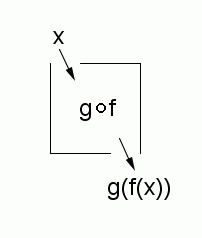Numbers can be ‘connected’ to get new numbers: for example,
$\,1+2=3\,.$
Indeed, addition ‘$\,+\,$’ is a connective for numbers.
Sets can be ‘connected’ to get new sets: for example,
$\,\{1\} \cup \{2\}=\{1,2\}\,.$
Indeed, the union operator ‘$\,\cup\,$’ is a connective for sets.
Functions can also be ‘connected’ to get new functions:
the most important way to do this, called function composition, is the subject of this section.
First, some basic review.
A function is a rule that takes an input, does something to it, and gives a unique corresponding output.
If the function name is $\,f\,,$ and the input name is $\,x\,,$
then the unique corresponding output is called $\,f(x)\,$ (which is read as ‘$\,f\,$ of $\,x\,$’).
Note that $\,f\,$ and $\,f(x)\,$ are different mathematical expressions:
$f\,$ is the name of the function;
$f(x)\,$ is the output from the function $\,f\,$ when the input is $\,x\,.$
It is often helpful to think of a function as a ‘box’.
You drop an input in the top, something happens to the input inside the box, and the output drops out the bottom.
The box is labeled with the name of the function.

|
You can explore this ‘function box’
using GeoGebra by clicking here: (Please be patient. It may take a few minutes for GeoGebra to load.) |
|
Constructing a Composition of Functions
To construct a composition of functions,
An input $\,x\,$ is dropped into the first box (call it $\,f\,$),
giving the output $\,f(x)\,.$
Now, bundle these two functions $\,f\,$ and $\,g\,$
into a single, new, function: What should this new function be named? Certainly, the name should have something to do with both $\,f\,$ and $\,g\,.$
It can't be named $\,fg\,$ or $\,gf\,,$ because these names are already taken
In whatever name is decided upon, |
 |
|
The name that was decided upon is: $\,g\circ f\,$
For us (high school mathematics and most others), That is, by definition:
$(g\circ f)(x) := g(f(x))$
This sentence is read aloud as:“ $\,g\,$ circle $\,f\,$ of $\,x\,$ equals $\,g\,$ of $\,f\,$ of $\,x\,$”
A function like $\,g\circ f\,$ is called a composite function.
One thing that is a bit different is that
$\,g\circ f\,$ is a pretty long function name.
BE CAREFUL!! |

|
Let $\,f(x) = x^2\,$
and
$\,g(x) = 2x\,.$
Then,
| $\,(g\circ f)(x)$ | $:=$ | $g(f(x))$ | definition of the function $\,g\circ f$ |
| $=$ | $g(x^2)$ | work from the inside to the outside; substitute $\,x^2\,$ for $\,f(x)\,$ | |
| $=$ | $2x^2$ | apply the ‘multiply by $\,2\,$’ function, $\,g\,,$ to $\,x^2\,$ |
Also,
| $(f\circ g)(x)$ | $:=$ | $f(g(x))$ | definition of the function $\,f\circ g$ |
| $=$ | $f(2x)$ | work from the inside to the outside; substitute $\,2x\,$ for $\,g(x)\,$ | |
| $=$ | $(2x)^2$ | apply the squaring function, $\,f\,,$ to $\,2x\,$ | |
| $=$ | $4x^2$ | simplify |
Notice that $\,g(f(x))\,$
is not equal to
$\,f(g(x))\,.$
In general, function composition is not commutative.
You can explore function composition
using GeoGebra
by clicking here:
Composition of Functions
(Please be patient. It may take a few minutes for GeoGebra to load.)
by practicing the exercise at the bottom of this page.
When you're done practicing, move on to:
Advanced Set Concepts